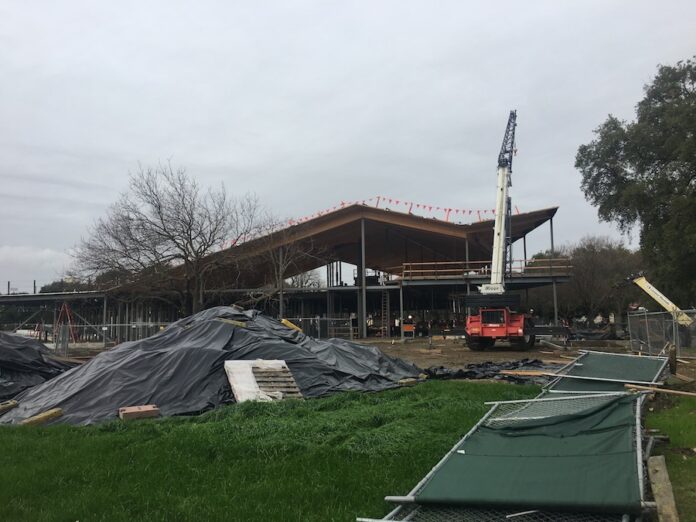A new building on the UC Davis campus is a part of the growing trend of using wood in large structures to reduce carbon emissions.
On the south side of campus, workers are busy installing a gigantic wooden roof that will cover the new Tercero Dining Commons 2, a new dining hall meant to accommodate more students. The roof is part of an international trend of using wood in large buildings. Although wood is not a new material, most large buildings are built with steel and concrete. Today, more architects are turning towards wood to build critical parts of large buildings because of environmental concerns and style considerations.
Shiling Pei, an assistant civil engineering professor at the Colorado School of Mines and an expert on wood buildings, said the trend is occurring for several reasons.
“The increasing market demand for wood buildings comes from the unique architectural features provided through exposed wood, environmental benefit of using sustainable material, and the efficiency and safety in construction provided through a high level of prefabrication,” Pei said.
Around the world, builders are using wood to replace and augment concrete and steel in new apartment buildings, office buildings and even skyscrapers. Developers recently proposed a wooden building that would be 21 stories in Milwaukee.
At UC Davis, the roof of the new dining hall is made of wooden panels and supported by long wooden beams. The designers chose wood for the roof because of its unique style.
Benjamin Caffey, an architect at Harley Ellis Devereaux, the firm that designed the building, described the stylized roof in an email: “The wood roof is exposed on the interior of the building and offers a natural warmth unattainable with other materials.”
Though the beauty of wood is driving more architects to use this material, there are other benefits to building with wood as well. Wood is a renewable material that fixes carbon dioxide, whereas steel and concrete are not renewable or environmentally friendly. The production of cement, the main ingredient of concrete, is responsible for about 5 percent of worldwide carbon dioxide emissions. Manufacturers use a lot of energy leading to indirect emissions, and they directly release carbon when they heat limestone, an important part of the production process. Manufacturing steel also releases large amounts of carbon. Many architects believe using wood will reduce these emissions.
“[Wood] is becoming attractive for construction because it is renewable and sequesters carbon,” Caffey said. “Its creation uses less energy and produces less carbon than steel or concrete.”
Wood buildings also satisfy another preference in the construction industry: pre-fabrication. Wood panels can be shipped to the build site pre-cut and finished and then assembled to form major components of the building with very little material waste. These prefabricated pieces are not the traditional wood beams milled from gigantic old growth trees. The majority of those trees were cut down in the early development of the United States.
“There are very few traditional old growth forests left,” said David Rizzo, a professor of plant pathology at UC Davis. “It’s a tiny percentage of what it was many years ago when Europeans first arrived here and started cutting trees down to build the cities.”
Today most lumber comes from tree plantations, where trees are planted and harvested like any other crop. These trees are generally much smaller and grow much faster than old growth trees. To produce large beams, engineers have designed sophisticated composite lumber products that can be formed into almost any shape or size. These products have existed for decades, but an increase in demand has led to new variations that are designed to be incredibly consistent, attractive and fire-resistant. A product called cross-laminated timber, designed in the 1990s and refined in the 2000s, is at the forefront of the wood construction boom.
Despite the excitement, some detractors are concerned about the stability and longevity of the new buildings. Engineers across the world are working to study the composite wood products and develop standards to keep people safe in these buildings. According to Pei, the results suggest that wood buildings are safe and long lasting.
“As of now, we have good evidence through research and full scale testing that at least for seismic performance, well-engineered wood buildings can withstand major earthquakes without much damage,” Pei said. “As for durability of wood buildings, look no further than well-engineered temples in Japan and China that have lasted over 800 years.” .
In the coming years, more and more large buildings will be built with wood to reduce carbon emissions and make building designs more compelling.
“There’s no doubt we will see the use of composite wood construction flourish in California,” Caffey said.
Students at UC Davis will get to experience the trend firsthand when the new Tercero Dining Hall opens next fall.
Written by: Peter Smith – science@theaggie.org
Editor’s note: An earlier version of this article stated that concrete is one of the main components of cement. That is incorrect. Cement is one of the main components of concrete. The Aggie regrets the error.





Honestly I can’t believe you would post FAKE NEWS on a previously reputable website… CEMENT is NOT made of Concrete! Concrete is cement with AGGREGATE!
Hi! I just wanted to let you know that there are some errors in this article. Cement is the main component of is concrete, not the other way around. That’s all. Thank you!